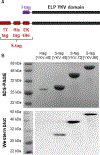Incorporation of short, charged peptide tags affects the temperature responsiveness of positively-charged elastin-like polypeptides
- PMID: 31384872
- PMCID: PMC7098454
- DOI: 10.1039/c9tb00821g
Incorporation of short, charged peptide tags affects the temperature responsiveness of positively-charged elastin-like polypeptides
Abstract
Elastin-like polypeptides (ELPs) are recombinant protein domains exhibiting lower critical solution temperature (LCST) behavior. This LCST behavior is controlled not only by intrinsic factors including amino acid composition and polypeptide chain length but also by non-ELP fusion domains. Here, we report that the presence of a composite non-ELP sequence that includes both His and T7 tags or a short Ser-Lys-Gly-Pro-Gly (SKGPG) sequence can dramatically change the LCST behavior of a positively-charged ELP domain. Both the His and T7 tags have been widely used in recombinant protein design to enable affinity chromatography and serve as epitopes for protein detection. The SKGPG sequence has been used to improve the expression of ELPs. Both the composite tag and the SKGPG sequence are <15% of the total length of the ELP fusion proteins. Despite the small size of the composite tag, its incorporation imparted pH-sensitive LCST behavior to the positively-charged ELP fusion protein. This pH sensitivity was not observed with the incorporation of the SKGPG sequence. The pH sensitivity results from both electrostatic and hydrophobic interactions between the composite tag and the positively-charged ELP domain. The hydrophobicity of the composite tag also alters the ELP interaction with Hofmeister salts by changing the overall hydrophobicity of the fusion protein. Our results suggest that incorporation of short tag sequences should be considered when designing temperature-responsive ELPs and provide insights into utilizing both electrostatic and hydrophobic interactions to design temperature-responsive recombinant proteins as well as synthetic polymers.
Figures








Similar articles
-
Predicting transition temperatures of elastin-like polypeptide fusion proteins.Biomacromolecules. 2013 May 13;14(5):1514-9. doi: 10.1021/bm400167h. Epub 2013 Apr 8. Biomacromolecules. 2013. PMID: 23565607 Free PMC article.
-
Protein purification by fusion with an environmentally responsive elastin-like polypeptide: effect of polypeptide length on the purification of thioredoxin.Biotechnol Prog. 2001 Jul-Aug;17(4):720-8. doi: 10.1021/bp010049o. Biotechnol Prog. 2001. PMID: 11485434
-
Effect of Peptide Sequence on the LCST-Like Transition of Elastin-Like Peptides and Elastin-Like Peptide-Collagen-Like Peptide Conjugates: Simulations and Experiments.Biomacromolecules. 2019 Mar 11;20(3):1178-1189. doi: 10.1021/acs.biomac.8b01503. Epub 2019 Feb 4. Biomacromolecules. 2019. PMID: 30715857
-
Elastin-like polypeptides: A strategic fusion partner for biologics.Biotechnol Bioeng. 2016 Aug;113(8):1617-27. doi: 10.1002/bit.25998. Epub 2016 Jun 3. Biotechnol Bioeng. 2016. PMID: 27111242 Review.
-
Biotechnological applications of elastin-like polypeptides and the inverse transition cycle in the pharmaceutical industry.Protein Expr Purif. 2019 Jan;153:114-120. doi: 10.1016/j.pep.2018.09.006. Epub 2018 Sep 11. Protein Expr Purif. 2019. PMID: 30217600 Review.
Cited by
-
Development of a Fast Organic Extraction-Precipitation Method for Improved Purification of Elastin-Like Polypeptides That Is Independent of Sequence and Molecular Weight.Biomacromolecules. 2021 May 10;22(5):1990-1998. doi: 10.1021/acs.biomac.1c00096. Epub 2021 Apr 7. Biomacromolecules. 2021. PMID: 33826307 Free PMC article.
-
Exploring LCST- and UCST-like Behavior of Branched Molecules Bearing Repeat Units of Elastin-like Peptides as Side Components.Biomacromolecules. 2024 Nov 11;25(11):7156-7166. doi: 10.1021/acs.biomac.4c00751. Epub 2024 Oct 9. Biomacromolecules. 2024. PMID: 39383337 Free PMC article.
-
Application of Elastin-like Polypeptide in Tumor Therapy.Cancers (Basel). 2022 Jul 28;14(15):3683. doi: 10.3390/cancers14153683. Cancers (Basel). 2022. PMID: 35954346 Free PMC article. Review.
-
Genetic and Covalent Protein Modification Strategies to Facilitate Intracellular Delivery.Biomacromolecules. 2021 Dec 13;22(12):4883-4904. doi: 10.1021/acs.biomac.1c00745. Epub 2021 Dec 2. Biomacromolecules. 2021. PMID: 34855385 Free PMC article. Review.
-
Architectural control of rod-coil block polypeptide thermoresponsive self-assembly via de novo design of coiled-coil orientation.J Mater Chem B. 2025 May 28;13(21):6164-6176. doi: 10.1039/d4tb02420f. J Mater Chem B. 2025. PMID: 40326759 Free PMC article.
References
-
- Kim Y-J and Matsunaga YT, J. Mater. Chem. B, 2017, 5, 4307–4321. - PubMed
-
- Wei M, Gao Y, Li X and Serpe MJ, Polym. Chem, 2017, 8, 127–143.
-
- Hrubý M, Filippov SK and Štěpánek P, Eur. Polym. J, 2015, 65, 82–97.
-
- Ashraf S, Park H-K, Park H and Lee S-H, Macromol. Res, 2016, 24, 297–304.
-
- Nash ME, Healy D, Carroll WM, Elvira C and Rochev YA, J. Mater. Chem, 2012, 22, 19376–19389.
Publication types
MeSH terms
Substances
Grants and funding
LinkOut - more resources
Full Text Sources
Other Literature Sources

